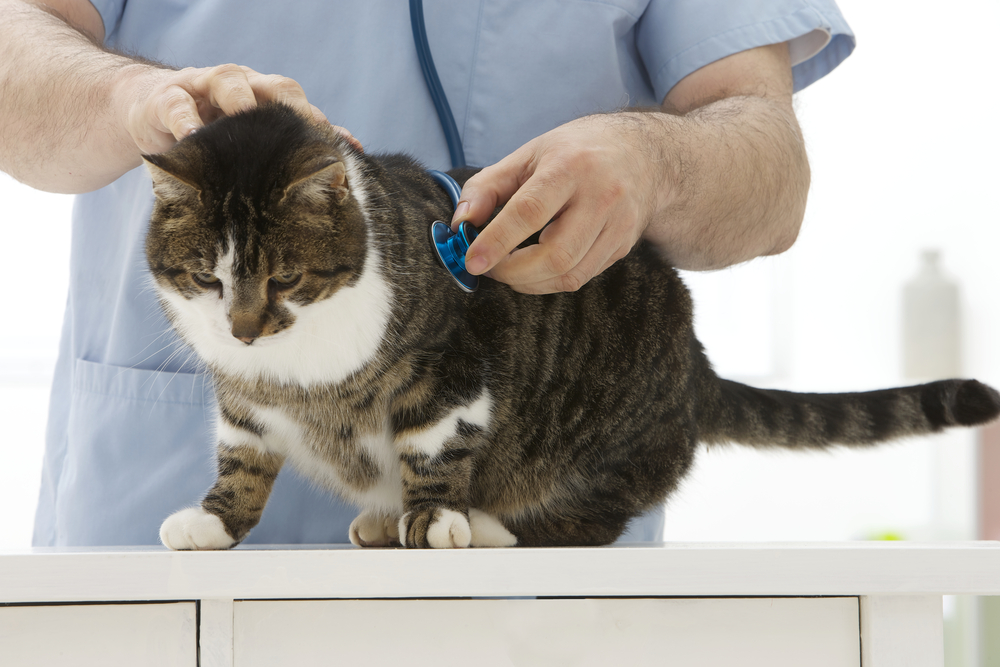

Toxoplasmosis is an infection caused by the Toxoplasma gondii (T. gondii) parasite. It is one of the most common parasitic diseases and is known to affect nearly all warm-blooded animals and humans, but cats are the primary living host.
This parasite completes its life cycle in cats, and they are the only mammals in which this parasite is passed through the feces and into the environment as part of the life cycle. However, contact with raw meat and unwashed produce is also a very significant and well known source of human infection.
Both acute and chronic forms of toxoplasmosis exist, where the chronic form is usually a low-grade disease without any clinical symptoms, and the acute form is more symptomatic.
Cats are more commonly seen with clinical symptoms as compared to dogs. Such symptoms include:
Symptoms are most severe in kittens infected while in the womb. These kittens may be stillborn or die before weaning. Those which survive may show show lack of appetite, fever, dyspnea, and jaundice.
Cats become infected through contact with the T. gondii parasite, which may be acquired from rooting in infected soil or from ingesting cat feces.
You will need to give a detailed history of your cat's health, onset and nature of symptoms, and possible incidents that might have precipitated this condition, such as contact with other cats. Your veterinarian will perform a thorough physical exam to evaluate your cat's body systems and to evaluate the overall health of your cat. Routine laboratory tests -- such as a complete blood count, biochemistry profile, and urinalysis -- are also used to confirm infection.
For example, cats with toxoplasmosis may show an abnormally low number of white blood cells (leukopenia), low neutrophils (neutropenia), and low lymphocytes (lymphopenia) in the complete blood count.
Conversely, during recovery, the complete blood count may reveal an increased number of white blood cells, an indication of the increased activity of the infection fighting white blood cells.
The biochemistry profile usually reveals abnormally high levels liver enzymes ALT (alanine aminotransferase ) and AST (aspartate aminotransferase). Moreover, the level of albumin (the protein normally present in the blood) is also found to be at decreased levels in some cats with toxoplasmosis; a medical condition known as hypoalbuminemia. In about 25 percent cats with toxoplasmosis, jaundice is seen with disturbed liver enzymes ALT and AST. The urinalysis may reveal abnormally high level of proteins and bilirubin in the urine sample. Fecal samples may also reveal important information, as infected cats frequently shed parasite eggs in their feces. If you have a sample of your cat's feces that you can take with your to your veterinarian, it may help to make the diagnosis and treatment move along faster.
Serological tests are the most reliable tests for making a definitive diagnosis. By measuring the levels of toxoplasma antigens in the body, your veterinarian can determine the type of infection, and whether it is active, dormant, recent (acute), or long term (chronic). Your veterinarian may repeat these tests three weeks after the initial testing as part of a follow-up exam.
Serological tests will also help in determining the levels of antibodies IgM and IgG. Antibodies are proteins that are normally present in the body or produced in response to an antigen (in this case toxoplasma) for the purpose of neutralizing the antigen. Determining the IgM levels helps in diagnosis of active toxoplasmosis, as these antibodies increase in number within one week of infection and may remain elevated for three months. The IgG antibodies increase within two to four weeks after infection and may remain elevated for a whole year to follow. Determination of antigen and antibody levels will help your veterinarian make the confirmatory diagnosis. The polymerase chain reaction test is a reliable test for verifying the presence of Toxoplasma gondii in samples.
Diagnostic imaging may also be called for, including a thoracic (chest) X-ray, which may show changes in the lung tissue, showing infection and marks of complications that are related to infection. Your veterinarian may also take a sample of lung fluid to determine the presence of the T. gondii organism, especially in cats with lung involvement. More advanced diagnostic testing includes taking a collection of cerebrospinal fluid (CSF). Laboratory testing of CSF may reveal an abnormally high number of white blood cells (WBCs) and protein concentrations in patients with infection that has reached the central nervous system.
In case of severe disease, your cat may need to be hospitalized for emergency treatment. Fluids are given intravenously in cats with poor hydration. Antibiotics are given to control the infection and prevent further progression of the disease into the system.
In cats with severe disease, proper nutrition and hydration is important for keeping the animal's health stable and for preventing a fatal outcome. However, in patients needing treatment because of severe symptoms, the overall prognosis is often very poor. Similarly, in kittens and immune-compromised patients, the prognosis is not favorable despite therapy.
Some antibiotics given to treat toxoplasmosis may cause side-effects, like vomiting, lack of appetite, and diarrhea. If you see any such untoward symptoms, consult your veterinarian for appropriate changes in therapy, since these side-effects can quickly become life threatening. Regular monitoring of the treatment response is required in patients under therapy. Your veterinarian will evaluate the treatment response by observing for improvements in symptoms like fever, lack of appetite, and eye problems.
While cats are the best known transmitters for the T. gondii parasite, it is important to remember that the parasite is more frequently acquired through handling raw meat and eating unwashed fruits and vegetables. The best protection against this parasite, for you and your cat, is through prevention and hygiene. Do not feed raw meat to your cat, and if you must allow your cat to go outdoors, be aware that your cat can easily acquire the parasite from other cats, from digging in dirt that is infected with the parasite, and from eating the meat of animals that are infected.
Other protective measures include covering outdoor sandboxes when not in use to prevent cats from using them as litter boxes, wearing gloves while gardening, washing hands after playing outside (particularly with children), wearing disposable gloves while changing the litter box (and possibly a face mask as well, if pregnant or immune compromised), and keeping the litter box clean on a daily basis. The longer the infected feces remains in the litter box, the more likely the possibility that the eggs of the parasite will become viable and infectious. If at all possible, pregnant women should avoid cleaning litter boxes, as this parasite has been known to cause severe complications during pregnancy. If it is unavoidable, make sure that all precautions are taken to avoid contact through the respiratory tract (face mask, disposable gloves).
It is possible to have your cat tested for this parasite, but the irony is that cats that test positive are less likely to be a threat of infectious transmission than cats that test negative, since cats that test positive are only testing positive for the antibodies to the parasite, meaning that they have already been previously infected and are now nearly immune to the infection; therefore, posing a much lower risk of being infectious. In fact, cats that have been infected with the T. gondii are generally immune to repeat infections for up to six years.
Conversely, if your cat tests negative for T. gondii antibodies, you will need to be that much more preventative in your approach to protecting your cat from infection, since they have no immunity to protect them from infection.
 Flea Control and Flea Bite Allergies in Cats
Flea Bite Hypersensitivity in Cats
Flea bite hype
Flea Control and Flea Bite Allergies in Cats
Flea Bite Hypersensitivity in Cats
Flea bite hype
 Particles in the Urine in Cats
Cylindruria in Cats
Particle matter in the urine
Particles in the Urine in Cats
Cylindruria in Cats
Particle matter in the urine
 Blood Related Deficiencies in Cats
Pancytopenia in Cats
Pancytopenia does not actual
Blood Related Deficiencies in Cats
Pancytopenia in Cats
Pancytopenia does not actual
 Hair Loss in Cats
Alopecia
Hair loss (alopecia) is a common problem
Hair Loss in Cats
Alopecia
Hair loss (alopecia) is a common problem
 How to Get Rid of Stray Cats and Kittens Under a Porch
How to Get Rid of Stray Cats and Kittens Under
How to Get Rid of Stray Cats and Kittens Under a Porch
How to Get Rid of Stray Cats and Kittens Under
Copyright © 2005-2016 Pet Information All Rights Reserved
Contact us: www162date@outlook.com